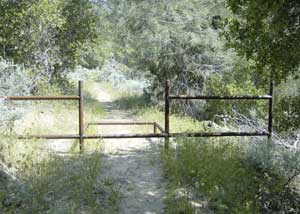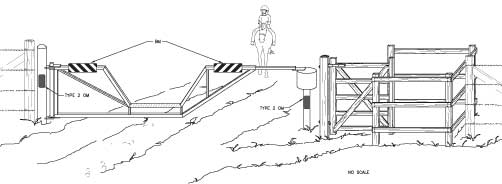
James "Scott" Groenier, Project Leader
The Missoula Technology and Development Center (MTDC) has reviewed available gate designs from around the world that allow wheelchair access, but restrict all-terrain vehicles (ATVs), motorcycles, and mountain bikes. We also searched for an existing gate or gate design that would allow access by wheelchairs and horses, but keep out ATVs and motorcycles.

Figure 1. Accessible Timber Kissing Gate
for Wheelchair Accessibility
click image for technical drawing
Highlights...
- When foot travel is encouraged past a gate blocking motorized access, the
Forest Service must provide a 32-inch-wide passage for persons using wheelchairs.
- This tech tip includes drawings of gate designs that will block all-terrain vehicles and motorcycles, but will allow wheel- chairs and, in some cases, horses to pass.
When the Forest Service installs a gate, berm, or other type of device to restrict motor vehicles on a road or trail, but encourages foot travel beyond the restriction, a passage 32 inches wide must be provided for someone using a wheelchair (Section 504 of the Rehabilitation Act of 1973).
Wheelchair Accessible GatesWeb sites with designs that allow wheelchair access while restricting access by ATVs and motorcycles are listed near the end of this tech tip. The best Web site was that of Scottish Natural Heritage, an organization in the United Kingdom (UK). They have a series of drawings for gate designs that meet accessibility requirements in the UK.
The Scottish Natural Heritage gates are smaller than those required for accessibility in the United States. We increased the opening dimensions to meet Federal requirements in the United States. The timber kissing gate (figure 1) and the chicane (figure 2) have been modified to meet the Federal requirements. In addition, a modified kissing gate design was developed to be used for existing fence openings (figure 3).

Figure 2. Chicane for Wheelchair Accessibility
click image for technical drawing

Figure 3. Timber Kissing Gate—Modification for Existing
Fence Opening for Wheelchair Accessibility
click image for technical drawing
Another concern was finding a way to allow horse and pedestrian access, while restricting ATVs and motorcycles. Two types of structures that will allow horse access, but restrict ATVs, are the "V" gates used at the Ashley National Forest (figures 4 and 5) and at the Lolo National Forest (figure 6).

Figure 4. A horse walking through a "V" gate in Utah.
This gate is not accessible because it is narrower
than the minimum width required for passage of a
wheelchair (32 inches) and the bar across
the opening is higher than 1 inch.

Figure 5. "V" Horse Gate
with Wheelchair Accessibility
click image for technical drawing
The bottom log should be removed from the gate shown in figure 6 because the log could be a tripping hazard and it prevents wheelchair access. A horse stile restricts ATVs and motorcycles and discourages mountain bikes, while allowing passage by horses (figure 7).

Figure 6—A gate in the Lolo National Forest that allows
horses to pass,
but restricts ATVs. This gate is not
accessible because it is narrower than the minimum width
required for passage of a wheelchair (32 inches) and
the bar across the opening is higher than 1 inch.

Figure 7—A horse stile. This gate is not accessible because
the bars
across the opening are higher than 1 inch.
The greatest challenge was to find a gate that allowed horses and wheelchairs to pass, but restricted all motorized traffic. The "V" gate design (see figure 5) allows wheelchairs and horses, but only restricts ATVs—not motorcycles. We combined the kissing gate (see figure 1) with the horse stile to design the horse gate with wheelchair accessibility (figure 8). Wheelchairs are able to go into the center of the gate, turn around and go out the other side. Horses can walk over the two stiles. The gate dimensions work well together because the required turning diameter for a wheelchair is 60 inches. This corresponds to the minimum required spacing of the stiles for horses to step over them in stride. The stile should be no higher than 12 inches because horses may choose to jump over stiles that are higher.

Figure 8. Horse Gate with Wheelchair Accessibility
click image for technical drawing
Many forest roads are closed to motor vehicle traffic by gates or other types of barriers. Often, foot travel is allowed beyond the restriction device. When foot travel is encouraged on the other side of the barrier, passage for someone in a wheelchair must be provided. The road closure drawings (figures 9 and 10) show four different ways to allow wheelchair access around a road closure gate, while restricting ATV use.

Figure 9. Forest Road Closure Gate with Wheelchair Accessibility
click image for technical drawing

Figure 10. Plan View and Elevation View of
Forest Road Closure Gate with "V" and "U" Chicanes
for Horse and Wheelchair Accessibility
click image for technical drawing
Another concern is not having enough room to allow both horse and wheelchair access around a road closure barrier. This may be remedied by installing an accessible gate for wheelchair access (see figures 9 and 10) and replacing the road gate with a horse-friendly barrier (figure 11). The kissing gate (see figure 1) may be added adjacent to a cattleguard on a road to allow wheelchair access, while restricting cattle.

Figure 11. Forest Road Closure Gate with "V" and "U" Chicanes
for Horse and Wheelchair Accessibility
click image for technical drawing
Mountain bikes, motorcycles, and small ATVs may be able to maneuver around obstacles and gates. In these cases, signs should be considered for additional travel management. All signs (including object markers) must meet the requirements of the Sign and Poster Guidelines for the Forest Service (EM 7100-15), chapter 6. Additionally, signs are required when mountain bikes or motorized vehicles are allowed on Forest Service trails.
SummaryThis project developed drawings for gates that meet the accessibility requirements for wheelchairs, horses, or both, but restrict motorized vehicle access. The new gates can help the Forest Service fulfill its policy of universal design, providing access to public lands for all people.
Web Sites for Gate Designs and Suppliers in the United Kingdom- Scottish Natural Heritage
- BTCV (British Trust for Conservation Volunteers)
- Bushey and District Footpaths Association (BADFA)
- Centrewire Ltd.
- Jackson's Fine Fencing
- American Trails
- National Center on Accessibility
- USDA Forest Service—Accessibility
Beneficial Designs, Inc., is working on a project called Designing an Accessible Vehicle Barrier for Trails. Beneficial Designs, Inc.
Beneficial Designs, Inc.
2240 Meridian Blvd., Suite C
Minden, NV 89423-8628
Phone: 775-783-8822
Fax: 775-783-8823
Web site: http://beneficialdesigns.com/169/
For information and assistance, the author would like to thank Ellen Eubanks, San Dimas Technology and Development Center; Gina Reese, Ashley National Forest; Donna Sheehy, Northern Region; and Janet Zeller, Washington Office.
Thanks to MTDC's publication and photography staffs, especially Sunni Bradshaw, for technical support and to Deb Mucci for design drawings.
DrawingsThe drawings in this tech tip are available on this disc.
These drawings can be viewed by Forest Service and Bureau of Land Management employees on their internal computer network at: http://fsweb.wo.fs.fed.us/eng/facilities/accrec/gates/
About the AuthorJames "Scott" Groenier, professional engineer, began working for MTDC as a project leader in 2003. Scott earned a bachelor's degree in civil and environmental engineering from the University of Wisconsin at Madison and a master's degree in civil engineering from Montana State University. He worked for the Wisconsin and Illinois State Departments of Transportation and with an engineering consulting firm before joining the Forest Service in 1992. He worked as the east zone structural engineer for the Eastern Region and as a civil engineer for the Ashley and Tongass National Forests before coming to MTDC.
Additional single copies of this publication may be ordered from:
USDA Forest Service
Missoula Technology and Development Center
5785 Hwy. 10 West
Missoula, MT 59808–9361
Phone: 406–329–3978
Fax: 406–329–3719
Email: wo_mtdc_pubs@fs.fed.us
Electronic copies of MTDC’s publications are available on the Internet at:
http://www.fs.fed.us/eng/pubs
Forest Service and Bureau of Land Management employees can search MTDC’s documents, CDs, DVDs, and videos on their internal computer networks at:
http://fsweb.mtdc.wo.fs.fed.us/search/
For additional information contact MTDC:
Phone: (406) 329-3900
Fax: 406–329–3719

